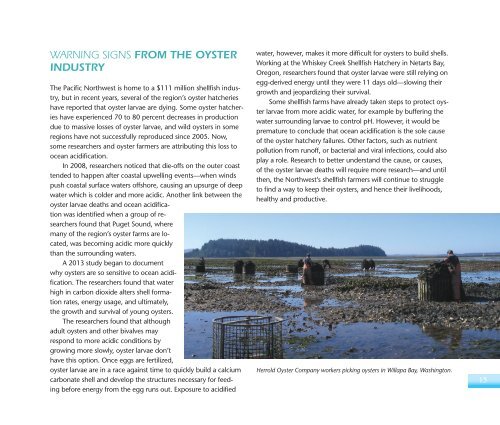OCEAN ACIDIFICATION Starting with the Science
SUMMARY DOCUMENT-Ocean Studies Board The National Academies—the National Academy of Sciences
SUMMARY DOCUMENT-Ocean Studies Board The National Academies—the National Academy of
Sciences
You also want an ePaper? Increase the reach of your titles
YUMPU automatically turns print PDFs into web optimized ePapers that Google loves.
WARNING SIGNS FROM THE OYSTER<br />
INDUSTRY<br />
The Pacific Northwest is home to a $111 million shellfish industry,<br />
but in recent years, several of <strong>the</strong> region’s oyster hatcheries<br />
have reported that oyster larvae are dying. Some oyster hatcheries<br />
have experienced 70 to 80 percent decreases in production<br />
due to massive losses of oyster larvae, and wild oysters in some<br />
regions have not successfully reproduced since 2005. Now,<br />
some researchers and oyster farmers are attributing this loss to<br />
ocean acidification.<br />
In 2008, researchers noticed that die-offs on <strong>the</strong> outer coast<br />
tended to happen after coastal upwelling events—when winds<br />
push coastal surface waters offshore, causing an upsurge of deep<br />
water which is colder and more acidic. Ano<strong>the</strong>r link between <strong>the</strong><br />
oyster larvae deaths and ocean acidification<br />
was identified when a group of researchers<br />
found that Puget Sound, where<br />
many of <strong>the</strong> region’s oyster farms are located,<br />
was becoming acidic more quickly<br />
than <strong>the</strong> surrounding waters.<br />
A 2013 study began to document<br />
why oysters are so sensitive to ocean acidification.<br />
The researchers found that water<br />
high in carbon dioxide alters shell formation<br />
rates, energy usage, and ultimately,<br />
<strong>the</strong> growth and survival of young oysters.<br />
The researchers found that although<br />
adult oysters and o<strong>the</strong>r bivalves may<br />
respond to more acidic conditions by<br />
growing more slowly, oyster larvae don’t<br />
have this option. Once eggs are fertilized,<br />
oyster larvae are in a race against time to quickly build a calcium<br />
carbonate shell and develop <strong>the</strong> structures necessary for feeding<br />
before energy from <strong>the</strong> egg runs out. Exposure to acidified<br />
water, however, makes it more difficult for oysters to build shells.<br />
Working at <strong>the</strong> Whiskey Creek Shellfish Hatchery in Netarts Bay,<br />
Oregon, researchers found that oyster larvae were still relying on<br />
egg-derived energy until <strong>the</strong>y were 11 days old—slowing <strong>the</strong>ir<br />
growth and jeopardizing <strong>the</strong>ir survival.<br />
Some shellfish farms have already taken steps to protect oyster<br />
larvae from more acidic water, for example by buffering <strong>the</strong><br />
water surrounding larvae to control pH. However, it would be<br />
premature to conclude that ocean acidification is <strong>the</strong> sole cause<br />
of <strong>the</strong> oyster hatchery failures. O<strong>the</strong>r factors, such as nutrient<br />
pollution from runoff, or bacterial and viral infections, could also<br />
play a role. Research to better understand <strong>the</strong> cause, or causes,<br />
of <strong>the</strong> oyster larvae deaths will require more research—and until<br />
<strong>the</strong>n, <strong>the</strong> Northwest’s shellfish farmers will continue to struggle<br />
to find a way to keep <strong>the</strong>ir oysters, and hence <strong>the</strong>ir livelihoods,<br />
healthy and productive.<br />
Herrold Oyster Company workers picking oysters in Willapa Bay, Washington.<br />
15


